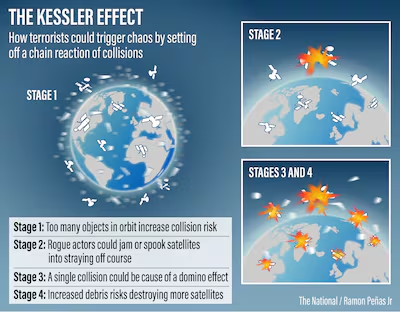Heads of major space agencies were put on the spot at the International Astronautical Congress about how they plan to make space exploration more sustainable, including efforts to curb the growing problem of debris.
Chiefs from Nasa and the European, Canadian, Chinese, Japanese and Indian space agencies took part in the panel hosted at the conference taking place in Milan until Friday.
With more than 40,500 objects longer than 10cm currently orbiting Earth, space debris is becoming a growing issue. Millions of smaller fragments also continue to accumulate, increasing the risk of collisions that could create even more hazardous debris.
Nasa chief Bill Nelson said it “was important that we take the problem seriously”, as space debris can be a danger to astronauts on board the International Space Station.

“We move the space station into a different orbit to miss a lot of the space junk that is up there,” he said. “There are new technologies that are being developed in order to try to help us get some of that space junk down. And it's important that we take this very seriously because it's getting very, very congested up there.”
Last year, Nasa proposed to use lasers to nudge orbital debris before a collision takes place.
Defunct satellites add to the debris problem by staying in orbit long after they have stopped functioning, turning into uncontrolled objects that can collide with other spacecraft. These collisions can break satellites into smaller fragments, creating even more debris that poses a threat to future missions.
In June, the defunct Russian Resurs-P1 satellite broke apart in low Earth orbit, creating more than 100 pieces of trackable debris, which is expected to remain in orbit for the next few months.
Responsible disposal of satellites
ESA’s director general Josef Aschbacher said it had received about 100 signatories for its Zero-Debris charter, which it established last year.
The charter states that whoever is launching a satellite must ensure it will be removed responsibly once its lifespan has ended.

“We are a space agency, we are not the regulator enforcing it, but we really call on all agency partners to voluntarily adhere to these principles, which are very simple,” said Mr Aschbacher.
The full list of signatories is not yet available but he said some European nations, the US and private American companies have signed.
The European Space Agency is developing its ClearSpace-1 mission, which will remove a defunct European satellite from orbit in 2026. If successful, the agency can use similar missions to clear other large pieces of junk.
Progress towards debris removal
Hiroshi Yamakawa, president of Japan Aerospace Exploration Agency, said it has launched the Commercial Removal of Debris Demonstration programme.
It teamed up with private company Astroscale to remove a large piece of space debris, an old Japanese rocket stage, in June.
The Adras-J mission had successfully approached the debris, inspected it and gathered critical data by making a close approach. "We're trying to actually remove that piece of debris in the near future," said Mr Yamakawa.





